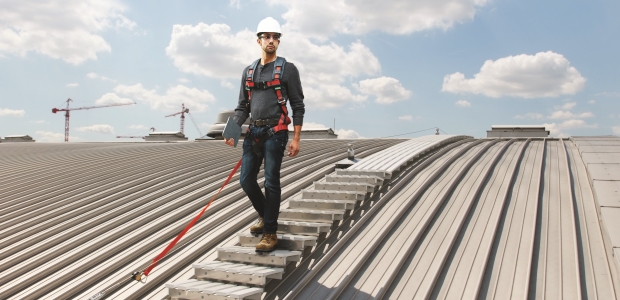
The Importance of Testing and Meeting Fall Protection Standards
Although ANSI standards are voluntary, they represent the consensus of industry experts and frequently provide more detailed product performance guidelines.
- By Anne Osbourn
- Jul 01, 2018
Make no mistake, working at heights is dangerous—falls remain the most common cause of work-related injuries and death. The U.S. Bureau of Labor Statistics reports around 750 fall-related fatalities a year and another 300,000 non-fatal falls requiring at least one day away from work. Other risks include damage to buildings, a negative impact on reputation, and an adverse effect on productivity and profitability when people miss work because of injury.
For those working in the health and safety industry, it's a constant challenge to source the best fall protection equipment. Products must comply with the latest standards and ultimately keep people working at heights safe.
It has never been more important for employers to ensure their fall protection systems meet the highest standards. Comprehensive fall protection planning often starts with equipment selection, so before you put a fall protection program in place, make sure you specify fully compliant fall protection products. When you choose equipment tested to meet the applicable standards, you prioritize the safety of your workers.
I speak with many people every day, from health and safety professionals to facilities managers. They all ask the same question: Which products and systems will really get the job done? My answer is always the same—choose the products that have been thoroughly tested to the very latest standards.
Test Methods
Fall protection equipment manufacturers have many things to consider when they evaluate their products, including establishing standardized test methods and demonstrating repeatable outcomes.
Therefore, when you investigate fall protection equipment for purchase, you must confirm that a manufacturer tests its offerings. For example, perhaps you are researching MSA fall protection equipment for a roofing project. When you evaluate our products, you will find we address the following areas:
- Intended purpose. We test our products based on their intended purpose. This shapes the entire testing process.
- Representative roof test. Our fall protection products undergo extensive testing with complete and representative roofing systems. This takes into consideration the supporting structure (purlins, decks, spacer system, insulation, and waterproofing cover) and enables us to achieve manufacturer approvals.
- Dynamic drop test. We conduct this test using a 660-pound mass dropped 5 feet from one post connected to the roofing system.
- Multi-directional testing. We test horizontally (i.e., perpendicular and in line) and at 45 degrees to the seam, profile, or deck—thus addressing possible fall angles.
Simply put, before you specify fall protection equipment of any kind, make sure that the manufacturer has conducted testing on the products you’re using to help protect your worker’s life and health in the event of a work-related fall.
Implementing ANSI Best Practices
By law, fall protection equipment must comply with the very latest Occupational Safety and Health Administration (OSHA) standards. It is essential that fall protection equipment is designed, tested, and manufactured so that in the foreseeable conditions of use for which it is intended, the user is able to perform the risk-related activity while being protected at the highest possible level. Employers and workers at height should bear this in mind when selecting fall protection equipment.
Fortunately, there is a step you can take to reduce the hazards that lead to fall-related accidents and fatalities, namely, taking American National Standards Institute (ANSI) standards seriously. Although these standards are voluntary, they represent the consensus of industry experts and frequently provide more detailed product performance guidelines. Fall protection equipment that meets stringent ANSI standards gives you additional peace of mind.
Steps to Prevent Falls
Once you've specified fall protection equipment for your employees, you can take steps to prevent them from falling in the first place.
1. First, remember what's at stake. It's your responsibility, as the employer, to provide your workers with the safest possible work environment.
2. Challenge yourself with important questions regarding your safety-at-heights program:
- Do we have the right people in the organization properly trained at all levels?
- Do we have a policy in place that addresses how we deal with fall hazards?
- Have we identified the fall hazards that exist at our facility?
- Are we systematically reducing those hazards in a prioritized way?
3. Once you've answered these questions, make a thorough assessment of all fall hazards, including sides and edges, hoist areas, and skylights.
4. Create a list of those hazards and schedule (at the very least) an annual review.
5. Document and implement appropriate protective measures, including procedures, protocols, and equipment.
6. Involve the employees working at heights. Be sure they know how to recognize and respond to fall hazards. If you involve them in identifying potential dangers and determining solutions, they should accept changes to their equipment and/or routine more willingly.
The list of steps outlined above is by no means exhaustive, and you should always be on the lookout for ways to improve your fall protection program.
An Industry-Wide Responsibility
It’s crucial for worker safety that both manufacturers and employers recognize the risks of not carrying out the right tests, not adhering to the latest standards, and not following industry best practices. These risks are especially pertinent in an age when we’re seeing increased numbers of people working at heights—from roofs to electricity towers to cranes and more.
Ultimately, we must all work together to assist in protecting people from injury and death by providing them with the best fall protection systems possible.
This article originally appeared in the July 2018 issue of Occupational Health & Safety.